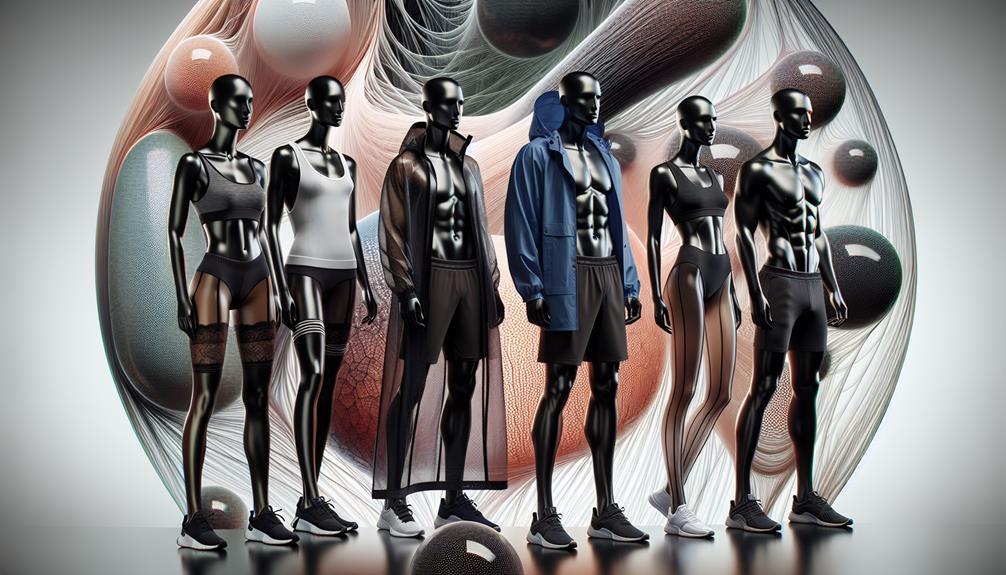I've noticed that nylon is super popular in clothing for a bunch of good reasons. It's really durable, so it lasts a long time without wearing out. It's also resistant to wrinkles and doesn't soak up moisture easily, making it super easy to care for. Plus, nylon clothes keep their shape and color after many washes. It's lightweight and adds a bit of stretch, which means your outfits are not only comfy but also fit really well. There's also a shift towards using more eco-friendly nylon, which uses less water and can be recycled. There's even more to uncover about the benefits and innovations of nylon.
Table of Contents
Key Takeaways
- Nylon is durable and resistant to wrinkles, making it ideal for long-lasting clothing.
- Its lightweight nature and flexibility offer comfort in garments.
- Nylon retains its shape and color well, enhancing the longevity of clothes.
- The material is easy to care for, typically requiring only machine washing and air drying.
- Nylon provides a cost-effective option due to its affordability and versatility in fashion.
Nylon's Durability and Strength
Nylon's remarkable durability and strength make it a top choice for clothing designed to endure tough conditions. I've noticed that its unique molecular structure not only contributes to this toughness but also provides incredible resilience. This means clothes made from nylon can handle a lot of stress without tearing or stretching out of shape. It's no wonder why so many outdoor and performance wear brands rely on nylon to produce gear that can withstand the elements and rigorous use.
Another key feature I've found in nylon is its abrasion resistance. This quality ensures that clothes don't just wear down after a few uses. Instead, they maintain their integrity, looking as good as new for longer, despite frequent wear. The high tensile strength of nylon fibers plays a huge part here, supporting heavy loads and resisting any forces that attempt to stretch it beyond its limit.
I've also appreciated how nylon's strength isn't compromised over time. It consistently preserves its characteristics, making it a smart choice for anyone looking for clothing that offers both performance and longevity. Its resilience against various environmental challenges only adds to its appeal as a go-to fabric for durable clothing.
Resistance to Wear and Tear
When I think about why nylon is popular in clothing, its resistance to wear and tear is a huge factor. This material's durability means clothes don't just last longer; they also look good for ages, despite frequent use.
It's perfect for everyday items that need to handle a bit of rough and tumble without falling apart.
Enhanced Durability Benefits
Clothing made from nylon offers outstanding durability due to its high resistance to wear and tear. This fabric's toughness and abrasion resistance make it a top choice for anyone needing reliable, long-lasting wear. Nylon doesn't just resist tearing; it stands up against frequent stretching and shrinking, keeping its shape through countless washes and wears.
Here's a quick breakdown of why nylon is so durable:
| Feature | Benefit | Impact on Clothing |
|---|---|---|
| High toughness | Resists tears and snags | Maintains structural integrity |
| Abrasion resistance | Withstands friction and rubbing | Extends garment lifespan |
| Resilience to deformation | Resists stretching and shrinking | Preserves fit and form |
Nylon's longevity isn't just about lasting longer; it's about looking good while doing it.
Long-Lasting Material Properties
I've noticed that nylon's ability to resist wear and tear makes it an ideal choice for everyday clothing. This durability stems from the robust manufacturing process that enhances the strength and elasticity of these synthetic fibers. Because of these properties, nylon fabrics can withstand frequent use and heavy loads, which is vital for various uses of nylon in clothing.
Whether it's sports gear or daily wear, this material holds up incredibly well against elements like wind and water, not to mention mold and chemicals. Its ability to blend with other fibers also allows for creating exceptionally durable and functional garments. Plus, the versatility in dyeing options gives manufacturers endless design possibilities, making nylon an invaluable asset in the fashion industry.
Comfort and Smoothness
Nylon's smooth and soft texture makes it incredibly comfortable to wear, feeling luxurious against the skin. There's a reason it's so popular in clothing, especially in items like lingerie and athletic wear. Its softness ensures that clothes aren't just functional but also a pleasure to have on. This luxurious feel isn't just about comfort; it elevates the entire experience of dressing up.
Moreover, nylon's sleek appearance adds to its appeal. Clothes made from nylon don't just feel good; they look polished and refined. Whether it's a sharp business suit or a flowing evening gown, nylon can enhance the garment's overall aesthetic, making it appear more sophisticated. Its lightweight nature plays a big part in this too. You hardly feel like you're wearing anything heavy, which is a big plus for comfort and movement. I've always appreciated how nylon garments allow for such freedom of movement without sacrificing style.
The elasticity of nylon is another key feature. It offers just the right amount of stretch, making clothes fit better and more comfortably. This flexibility means that whether I'm at a yoga class or a busy day at work, my nylon outfits work with me, not against me.
Low Moisture Absorbency
One of the best things about nylon is its quick drying feature.
When I'm out in humid conditions, my nylon clothes keep me comfortable because they don't soak up much moisture.
This makes nylon ideal for sportswear and rainy day outfits.
Quick Drying Benefits
When it comes to staying dry, nylon's low moisture absorbency means clothes dry quickly, which is perfect for swimwear and activewear. This quick drying benefit isn't just about comfort; it's essential for efficiency during outdoor activities. Imagine you're hiking or swimming; nylon ensures that your gear doesn't become heavy and bog you down as it resists soaking up water.
This property is a game changer, especially in scenarios where drying off quickly prevents discomfort and keeps you moving. Plus, for those of us who are constantly on the go, nylon's ability to shed moisture fast means less waiting around for clothes to dry. It's why I always lean towards nylon when planning an active day out.
Comfort in Humidity
In humid conditions, I find that clothing made from nylon stays comfortably dry, thanks to its low moisture absorbency. This characteristic is crucial because it prevents the fabric from becoming damp or heavy, which can be a real discomfort when I'm moving around.
I've noticed that nylon garments don't stick to my skin or get uncomfortable, even when I sweat. This is largely due to nylon's moisture-wicking properties, which pull moisture away from the body.
For someone like me who values comfort and breathability in clothing, nylon is a top choice in humid climates. Its ability to resist moisture keeps me feeling fresher and more comfortable, even on the muggiest days.
High Melting Point
Nylon's high melting point makes it ideal for clothing since it can withstand heat without losing shape during ironing or production processes. This resistance to heat is crucial not just for everyday care but also during the manufacturing stages where fabrics often encounter high temperatures. Imagine the process of creating activewear or outerwear—nylon's ability to endure these conditions without melting or deforming ensures the final product remains intact and reliable.
Furthermore, this high melting point directly contributes to the durability and longevity of nylon garments. Clothes need to last, withstand various stresses, and maintain their structural integrity. Nylon ticks all these boxes, making it a smart choice for items that aren't just worn but are used and reused frequently. For instance, consider stockings or sports apparel; they undergo constant stress and frequent washing, which involves heat.
The fact that nylon clothing can handle ironing and pressing without damage is another huge plus. It means that maintaining a polished, wrinkle-free look is entirely feasible, adding to the practicality of using nylon in fashion. All these factors—resistant to heat, structural integrity, and ease during ironing—show why nylon's high melting point isn't just a technical detail but a fundamental characteristic that enhances clothing quality.
Ease of Care and Maintenance
Building on its high melting point, nylon also offers the advantage of being exceptionally easy to care for and maintain. I've found that throwing my nylon clothes in the washing machine saves me a ton of time. They're machine washable, and you can just use regular detergents, which is super convenient. There's no need for any special cleaning agents, and thankfully, avoiding bleach keeps them in top-notch condition.
I stick to cool or warm wash settings. It's best for keeping my nylon gear looking good for longer, without any wear and tear that hot water might cause. Once washed, I usually hang them up for air drying. It's effortless and avoids the risks of high heat in tumble dryers that can shrink or warp the fabric.
Always, and I mean always, I check the garment care label. It's my go-to guide for making sure I'm not messing anything up. It's like having a cheat sheet for laundry day. Following these simple steps, my nylon outfits have lasted ages and still look as good as new. It's really all about sticking to these basics to keep them in great shape.
Versatility in Fashion
I've always appreciated how nylon's versatility makes it a staple in diverse fashion designs. It's not just the range of colors and patterns it can be dyed into that catches the eye; its intrinsic qualities contribute significantly to fashion design. Nylon's lightweight nature is a godsend, allowing designers to craft everything from airy summer dresses to essential sportswear without the bulk. This material blends comfort with functionality seamlessly.
The durability of nylon is another cornerstone that makes it so valuable. Clothing items need to withstand wear and tear, and nylon's robustness ensures that clothes not only last but also maintain their integrity over time. It's reassuring to know that the vibrant blouse or the sturdy hiking gear won't easily succumb to the elements.
Moreover, nylon's resistance powers add another layer of utility. It resists wind, water, mold, and even chemicals, making it perfect for outdoor clothing and accessories. These protective qualities mean that fashion isn't just about looks but also about practicality. Whether it's a chic windbreaker or a durable pair of leggings, nylon brings its A-game to all aspects of fashion. This blend of style, comfort, and durability is why nylon remains a favorite in the fashion industry.
Cost-Effectiveness
One of the biggest advantages of nylon is its cost-effectiveness, making it a popular choice for both designers and consumers. As I delve deeper into why nylon is so integral to the fashion industry, it's clear that its affordability is a key factor. The manufacturing process of nylon isn't just efficient; it keeps production costs low, which in turn makes the fabric budget-friendly for clothing companies.
This cost-effectiveness doesn't end at the factory door. Clothing made from nylon tends to last longer due to its inherent durability, providing consumers with garments that offer significant value for money. I've noticed that this aspect is particularly appealing because it means spending less over time on replacements or repairs. Essentially, nylon strikes a perfect balance between quality and affordability, which is exactly what both high street brands and luxury designers are looking for.
Moreover, the economical production and lasting nature of nylon allow for a wide variety of clothing items to be produced at competitive prices. This versatility in application without sacrificing quality or raising costs further cements nylon's status as a staple in the wardrobe of budget-conscious shoppers. In this way, nylon truly exemplifies how a material can be both cost-effective and durable, making it a smart choice for the savvy consumer.
Variety of Textures and Finishes
Nylon's ability to adopt various textures and finishes makes it a versatile choice for fashion designers aiming to innovate and diversify their clothing lines. The adaptability of nylon fabric in creating a wide array of textures and finishes is crucial for tailoring specific looks and enhancing the aesthetic appeal of different clothing designs. Here's how:
- Diverse Finishes: Nylon can be processed to have a smooth, matte, or shiny finish. This versatility allows designers to produce everything from high-gloss leggings to subtle office wear, making nylon indispensable in varied fashion contexts.
- Mimicking Natural Fibers: The ability to imitate the look and feel of natural fibers like silk or cotton adds a luxurious dimension to nylon garments without compromising on durability or cost-effectiveness.
- Innovative Texturing: Techniques such as crinkling, embossing, or brushing enrich nylon textiles with unique tactile sensations and visual depth, offering endless creative possibilities for designers.
- Style Adaptation: The variety of available textures and finishes means nylon can seamlessly integrate into diverse fashion genres, from sportswear to high fashion, continually expanding its utility in the fashion industry.
This flexibility and ingenuity make nylon a powerhouse in the textile world, continually pushing the boundaries of what's possible in clothing designs.
Environmental Considerations
Despite its versatility in fashion, the production and disposal of nylon pose significant environmental challenges. Producing nylon is notably energy-intensive, primarily because it relies heavily on crude oil. This dependence not only depletes natural resources but also amplifies the fabric's carbon footprint. Moreover, once it's made, nylon isn't doing any favors for the planet either. It's non-biodegradable, hanging around in landfills for centuries, reluctant to break down.
Handling disposal and recycling is equally critical. Without proper recycling processes, nylon waste accumulates, exacerbating environmental issues. However, there's a silver lining with some brands stepping up, reclaiming materials like lost fishing nets to produce recycled nylon. This initiative marks a significant move towards sustainability.
One can't overlook nylon's durability, though. This attribute is somewhat of an environmental double-edged sword. On one hand, its longevity means garments don't need to be replaced as often, which theoretically reduces waste. But on the flip side, once these items do reach the end of their life, they're a headache to dispose of responsibly.
Innovations in Nylon Fabrication
While acknowledging the environmental challenges, I'll now explore how advancements in nylon fabrication contribute to more sustainable fashion practices. The innovations in the synthetic fabric industry, particularly with nylon, are truly reshaping our approach to eco-friendly clothing. Here's a breakdown of key advancements:
- Nylon Blends: Merging nylon with other fibers like polyester and cotton enhances both functionality and sustainability. These technical fabrics offer improved resistance to elements like wind and water while reducing reliance on purely synthetic materials.
- Soft, Lightweight Nylon: Innovations have led to the development of softer, more breathable versions of nylon that maintain durability but increase comfort. This makes nylon more versatile for a wider range of clothing items.
- High-Tech Polyester Taffeta: This specialized fabric incorporates nylon to create garments that are robust yet lightweight, ideal for outdoor and performance wear. It's another step towards more functional yet fashionable clothing.
- Recycled Nylon Options: The introduction of products like recycled nylon V006 highlights significant progress in reducing waste and promoting recycling in the fabric industry. These recycled nylon options are pivotal in pushing the boundaries of sustainable fashion.
These innovations in nylon fabrication not only enhance the performance and appeal of garments but also significantly contribute to more sustainable fashion practices.
Frequently Asked Questions
What Is Nylon Used for in Clothing?
Nylon's used in clothing primarily for its durability and resistance to wear. It's ideal for sportswear due to its ability to withstand frequent use and various weather conditions. It also blends well with other fibers.
Why Is Nylon Popular for Making Clothes?
Nylon's popularity in clothing stems from its durability, versatility in weather resistance, and aesthetic flexibility. It's great for sportswear and constantly evolves through technological advances, making it increasingly sustainable.
What Are the Benefits of Nylon Fabric?
I've found that nylon fabric is extremely durable, resisting wear and tear. It's also versatile, blending well with other fibers, and can be dyed in various colors, making it ideal for diverse clothing designs.
Why Is Nylon Better Than Cotton?
Nylon's superior to cotton because it's stronger, more durable, and better resists wind, water, and wear. It's also more versatile in design, which lets me create more dynamic and lasting clothing pieces.
- What Are the Disadvantages of Lyocell? - April 19, 2024
- Is Tencel Lyocell Long-Lasting? - April 19, 2024
- Is Tencel Lyocell Better Than Cotton? - April 19, 2024








